Comprehensive Analysis: System Development at James Healthcare Centre
VerifiedAdded on 2020/05/28
|15
|2797
|144
Report
AI Summary
This report provides a comprehensive analysis of the system development at James Healthcare Centre (JHC). It begins by outlining the functional requirements, including Electronic Medical Records (EMR), database, Clinical Decision Support System (CDSS), data mining, Computerized Physician Order Entry (CPOE), billing, attendance tracking, audit, payroll, and appointment scheduling. Non-functional requirements such as security, availability, usability, and scalability are also detailed. The report then presents a use case diagram to capture the dynamic aspects of the system and a domain model class diagram to visualize the static view. An event-based partition system is discussed to organize requirements. Finally, the report recommends the Agile SDLC model for its flexibility and suitability for complex projects, detailing the phases of pre-project planning, project initiation, construction iteration, end game, production, and retirement. The analysis is supported by diagrams and references to relevant literature.

Running head: SYSTEM DEVELOPMENT AT JHC
System Development at JHC
Name of the Student
Name of the University
System Development at JHC
Name of the Student
Name of the University
Paraphrase This Document
Need a fresh take? Get an instant paraphrase of this document with our AI Paraphraser
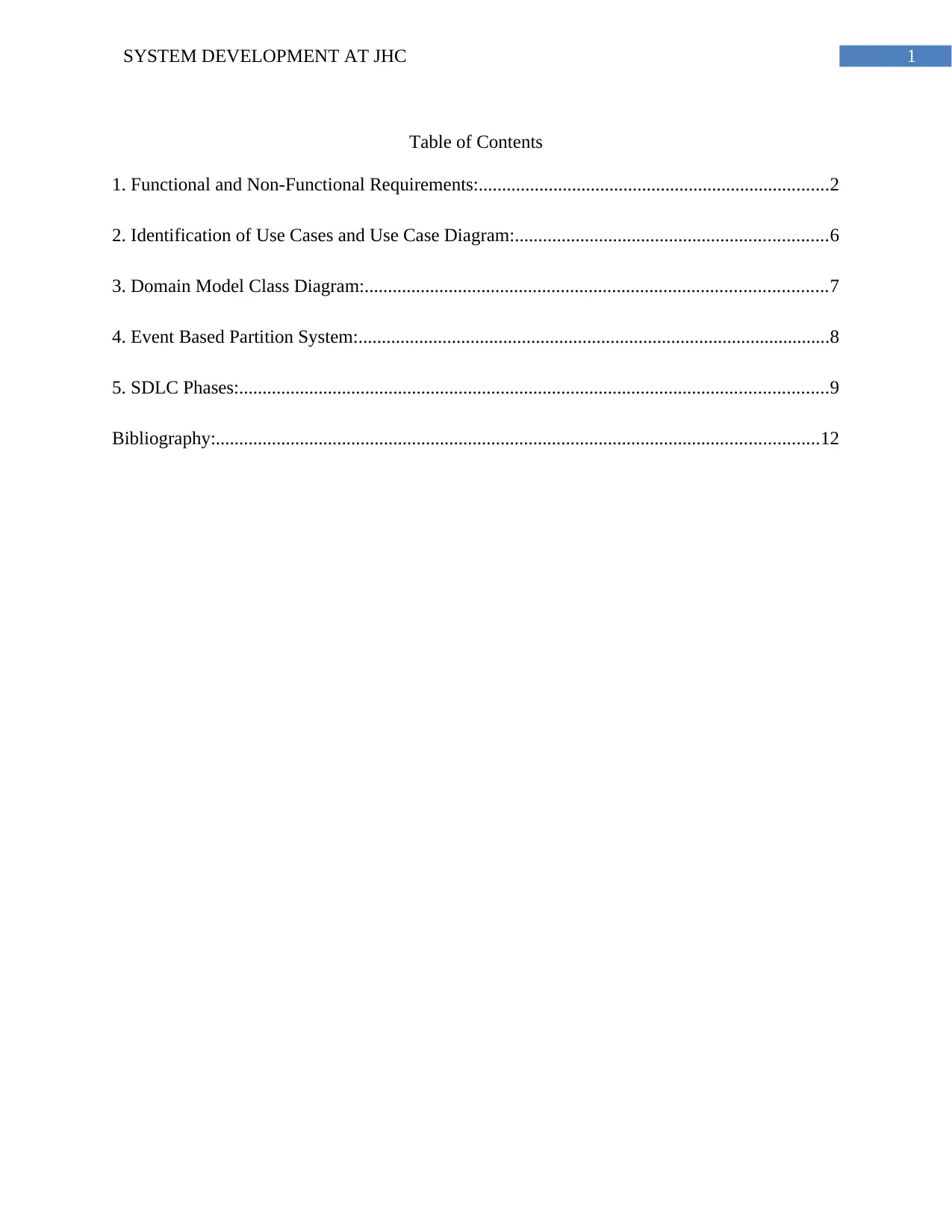
1SYSTEM DEVELOPMENT AT JHC
Table of Contents
1. Functional and Non-Functional Requirements:...........................................................................2
2. Identification of Use Cases and Use Case Diagram:...................................................................6
3. Domain Model Class Diagram:...................................................................................................7
4. Event Based Partition System:.....................................................................................................8
5. SDLC Phases:..............................................................................................................................9
Bibliography:.................................................................................................................................12
Table of Contents
1. Functional and Non-Functional Requirements:...........................................................................2
2. Identification of Use Cases and Use Case Diagram:...................................................................6
3. Domain Model Class Diagram:...................................................................................................7
4. Event Based Partition System:.....................................................................................................8
5. SDLC Phases:..............................................................................................................................9
Bibliography:.................................................................................................................................12
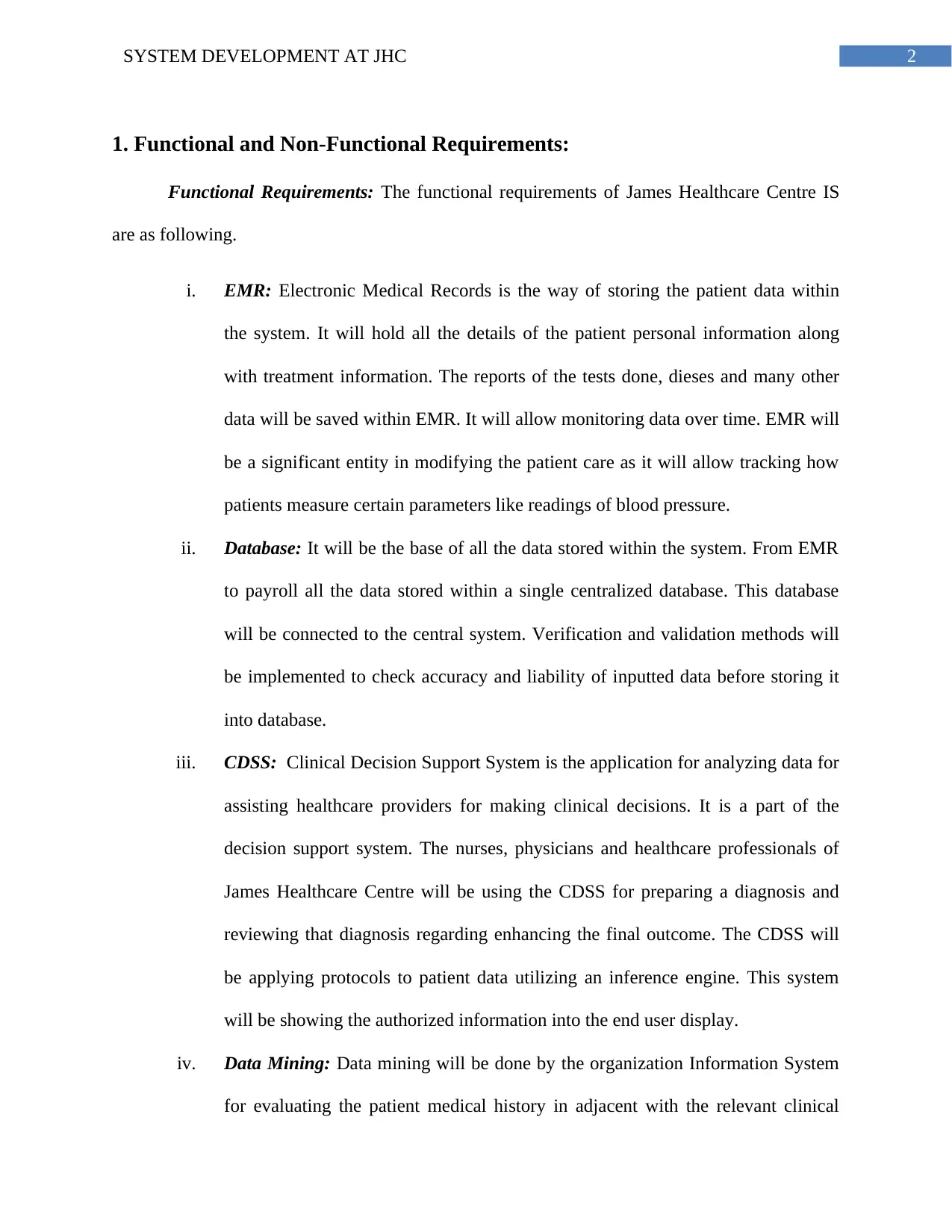
2SYSTEM DEVELOPMENT AT JHC
1. Functional and Non-Functional Requirements:
Functional Requirements: The functional requirements of James Healthcare Centre IS
are as following.
i. EMR: Electronic Medical Records is the way of storing the patient data within
the system. It will hold all the details of the patient personal information along
with treatment information. The reports of the tests done, dieses and many other
data will be saved within EMR. It will allow monitoring data over time. EMR will
be a significant entity in modifying the patient care as it will allow tracking how
patients measure certain parameters like readings of blood pressure.
ii. Database: It will be the base of all the data stored within the system. From EMR
to payroll all the data stored within a single centralized database. This database
will be connected to the central system. Verification and validation methods will
be implemented to check accuracy and liability of inputted data before storing it
into database.
iii. CDSS: Clinical Decision Support System is the application for analyzing data for
assisting healthcare providers for making clinical decisions. It is a part of the
decision support system. The nurses, physicians and healthcare professionals of
James Healthcare Centre will be using the CDSS for preparing a diagnosis and
reviewing that diagnosis regarding enhancing the final outcome. The CDSS will
be applying protocols to patient data utilizing an inference engine. This system
will be showing the authorized information into the end user display.
iv. Data Mining: Data mining will be done by the organization Information System
for evaluating the patient medical history in adjacent with the relevant clinical
1. Functional and Non-Functional Requirements:
Functional Requirements: The functional requirements of James Healthcare Centre IS
are as following.
i. EMR: Electronic Medical Records is the way of storing the patient data within
the system. It will hold all the details of the patient personal information along
with treatment information. The reports of the tests done, dieses and many other
data will be saved within EMR. It will allow monitoring data over time. EMR will
be a significant entity in modifying the patient care as it will allow tracking how
patients measure certain parameters like readings of blood pressure.
ii. Database: It will be the base of all the data stored within the system. From EMR
to payroll all the data stored within a single centralized database. This database
will be connected to the central system. Verification and validation methods will
be implemented to check accuracy and liability of inputted data before storing it
into database.
iii. CDSS: Clinical Decision Support System is the application for analyzing data for
assisting healthcare providers for making clinical decisions. It is a part of the
decision support system. The nurses, physicians and healthcare professionals of
James Healthcare Centre will be using the CDSS for preparing a diagnosis and
reviewing that diagnosis regarding enhancing the final outcome. The CDSS will
be applying protocols to patient data utilizing an inference engine. This system
will be showing the authorized information into the end user display.
iv. Data Mining: Data mining will be done by the organization Information System
for evaluating the patient medical history in adjacent with the relevant clinical
⊘ This is a preview!⊘
Do you want full access?
Subscribe today to unlock all pages.

Trusted by 1+ million students worldwide
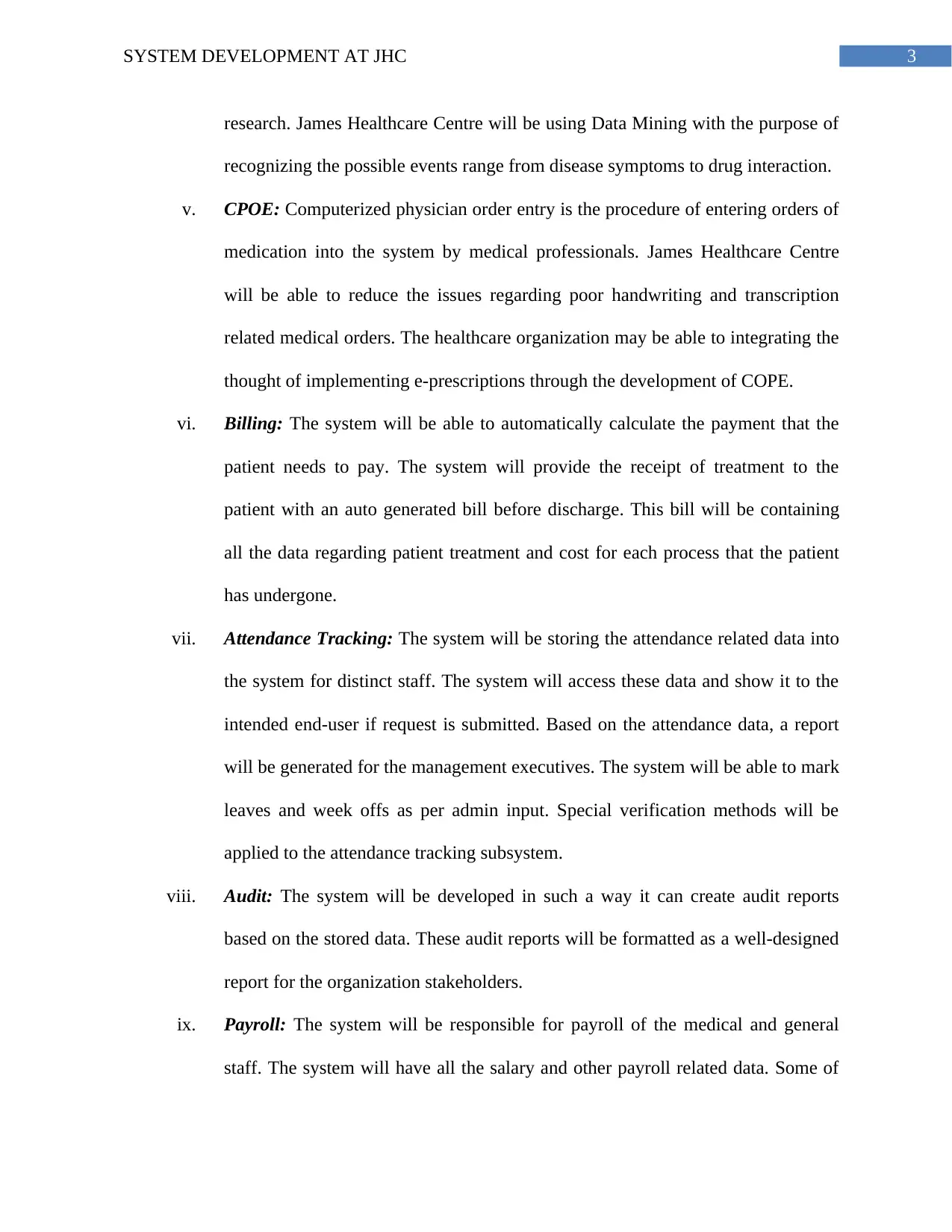
3SYSTEM DEVELOPMENT AT JHC
research. James Healthcare Centre will be using Data Mining with the purpose of
recognizing the possible events range from disease symptoms to drug interaction.
v. CPOE: Computerized physician order entry is the procedure of entering orders of
medication into the system by medical professionals. James Healthcare Centre
will be able to reduce the issues regarding poor handwriting and transcription
related medical orders. The healthcare organization may be able to integrating the
thought of implementing e-prescriptions through the development of COPE.
vi. Billing: The system will be able to automatically calculate the payment that the
patient needs to pay. The system will provide the receipt of treatment to the
patient with an auto generated bill before discharge. This bill will be containing
all the data regarding patient treatment and cost for each process that the patient
has undergone.
vii. Attendance Tracking: The system will be storing the attendance related data into
the system for distinct staff. The system will access these data and show it to the
intended end-user if request is submitted. Based on the attendance data, a report
will be generated for the management executives. The system will be able to mark
leaves and week offs as per admin input. Special verification methods will be
applied to the attendance tracking subsystem.
viii. Audit: The system will be developed in such a way it can create audit reports
based on the stored data. These audit reports will be formatted as a well-designed
report for the organization stakeholders.
ix. Payroll: The system will be responsible for payroll of the medical and general
staff. The system will have all the salary and other payroll related data. Some of
research. James Healthcare Centre will be using Data Mining with the purpose of
recognizing the possible events range from disease symptoms to drug interaction.
v. CPOE: Computerized physician order entry is the procedure of entering orders of
medication into the system by medical professionals. James Healthcare Centre
will be able to reduce the issues regarding poor handwriting and transcription
related medical orders. The healthcare organization may be able to integrating the
thought of implementing e-prescriptions through the development of COPE.
vi. Billing: The system will be able to automatically calculate the payment that the
patient needs to pay. The system will provide the receipt of treatment to the
patient with an auto generated bill before discharge. This bill will be containing
all the data regarding patient treatment and cost for each process that the patient
has undergone.
vii. Attendance Tracking: The system will be storing the attendance related data into
the system for distinct staff. The system will access these data and show it to the
intended end-user if request is submitted. Based on the attendance data, a report
will be generated for the management executives. The system will be able to mark
leaves and week offs as per admin input. Special verification methods will be
applied to the attendance tracking subsystem.
viii. Audit: The system will be developed in such a way it can create audit reports
based on the stored data. These audit reports will be formatted as a well-designed
report for the organization stakeholders.
ix. Payroll: The system will be responsible for payroll of the medical and general
staff. The system will have all the salary and other payroll related data. Some of
Paraphrase This Document
Need a fresh take? Get an instant paraphrase of this document with our AI Paraphraser

4SYSTEM DEVELOPMENT AT JHC
the data will be inputted by the admin. The payroll will be the central process of
the system.
x. Appointment: The system will be scheduling appointments based on the patient
input and attendance of medical staff. All the details of the appointment will be
stored in the database. After an appointment, the patient can request for next
appointment.
Non-Functional Requirements: The non-functional requirements of the system are as
following.
i. Security: High security is a highly required feature of information system. The
system will be storing the bank account details of the staff and patients. All the
personal data of stakeholders will also be stored in the system. In such situation,
the system must be able to prevent and block cyber-attacks. The increase in the
DDoS attack in the recent year has created a serious issue in IT. James Healthcare
Centre can employ a third party security provider so that attacks like DDoS, cyber
espionage and others can be prevented. Various protocols will be implied on the
end-users of the system to prevent security exploitation form inside.
ii. Availability: Availability is a significant feature of the proposed information
system. If the system goes down all the process of James Healthcare Centre will
be disrupted. The system must be able to provide support business 24*7 without
any interruption. A special IT team will be hired to maintain the system
functionality. If the system is not available, the health organization will be
running process temporarily on the paper based work. The subsystems will be
running individually. If one subsystem like appointment handling gets down,
the data will be inputted by the admin. The payroll will be the central process of
the system.
x. Appointment: The system will be scheduling appointments based on the patient
input and attendance of medical staff. All the details of the appointment will be
stored in the database. After an appointment, the patient can request for next
appointment.
Non-Functional Requirements: The non-functional requirements of the system are as
following.
i. Security: High security is a highly required feature of information system. The
system will be storing the bank account details of the staff and patients. All the
personal data of stakeholders will also be stored in the system. In such situation,
the system must be able to prevent and block cyber-attacks. The increase in the
DDoS attack in the recent year has created a serious issue in IT. James Healthcare
Centre can employ a third party security provider so that attacks like DDoS, cyber
espionage and others can be prevented. Various protocols will be implied on the
end-users of the system to prevent security exploitation form inside.
ii. Availability: Availability is a significant feature of the proposed information
system. If the system goes down all the process of James Healthcare Centre will
be disrupted. The system must be able to provide support business 24*7 without
any interruption. A special IT team will be hired to maintain the system
functionality. If the system is not available, the health organization will be
running process temporarily on the paper based work. The subsystems will be
running individually. If one subsystem like appointment handling gets down,

5SYSTEM DEVELOPMENT AT JHC
other processes will be running after the subsystem starts running all the data will
be sent to the subsystem automatically.
iii. Usability: Usability refers to the feature of system that entails how easily the end
users will be able to interact with the system. The system will be using different
interfaces for different end-user types such as receptionists and management
executives will be accessing the system through different interface. These
interfaces will be designed as per data and functions required by the end-user. In
order to increase the usability, the system development team will be taking
feedbacks form the end-users and modify the interface. The interface will be
showing only the required information to the user. In order to access different
data, various buttons will be provided so that having all the data into one page
does not confuse the user.
iv. Scalability: The scalability refers to the system capability of managing usage of
resource. Managing resource usage is a significant way of cost saving. If the
admission of patient is low then system does not need to use all the resources it
needed during heavy admission. In such situation, the organization can reduce the
amount of resource so that cost of running business process can be reduced.
other processes will be running after the subsystem starts running all the data will
be sent to the subsystem automatically.
iii. Usability: Usability refers to the feature of system that entails how easily the end
users will be able to interact with the system. The system will be using different
interfaces for different end-user types such as receptionists and management
executives will be accessing the system through different interface. These
interfaces will be designed as per data and functions required by the end-user. In
order to increase the usability, the system development team will be taking
feedbacks form the end-users and modify the interface. The interface will be
showing only the required information to the user. In order to access different
data, various buttons will be provided so that having all the data into one page
does not confuse the user.
iv. Scalability: The scalability refers to the system capability of managing usage of
resource. Managing resource usage is a significant way of cost saving. If the
admission of patient is low then system does not need to use all the resources it
needed during heavy admission. In such situation, the organization can reduce the
amount of resource so that cost of running business process can be reduced.
⊘ This is a preview!⊘
Do you want full access?
Subscribe today to unlock all pages.

Trusted by 1+ million students worldwide
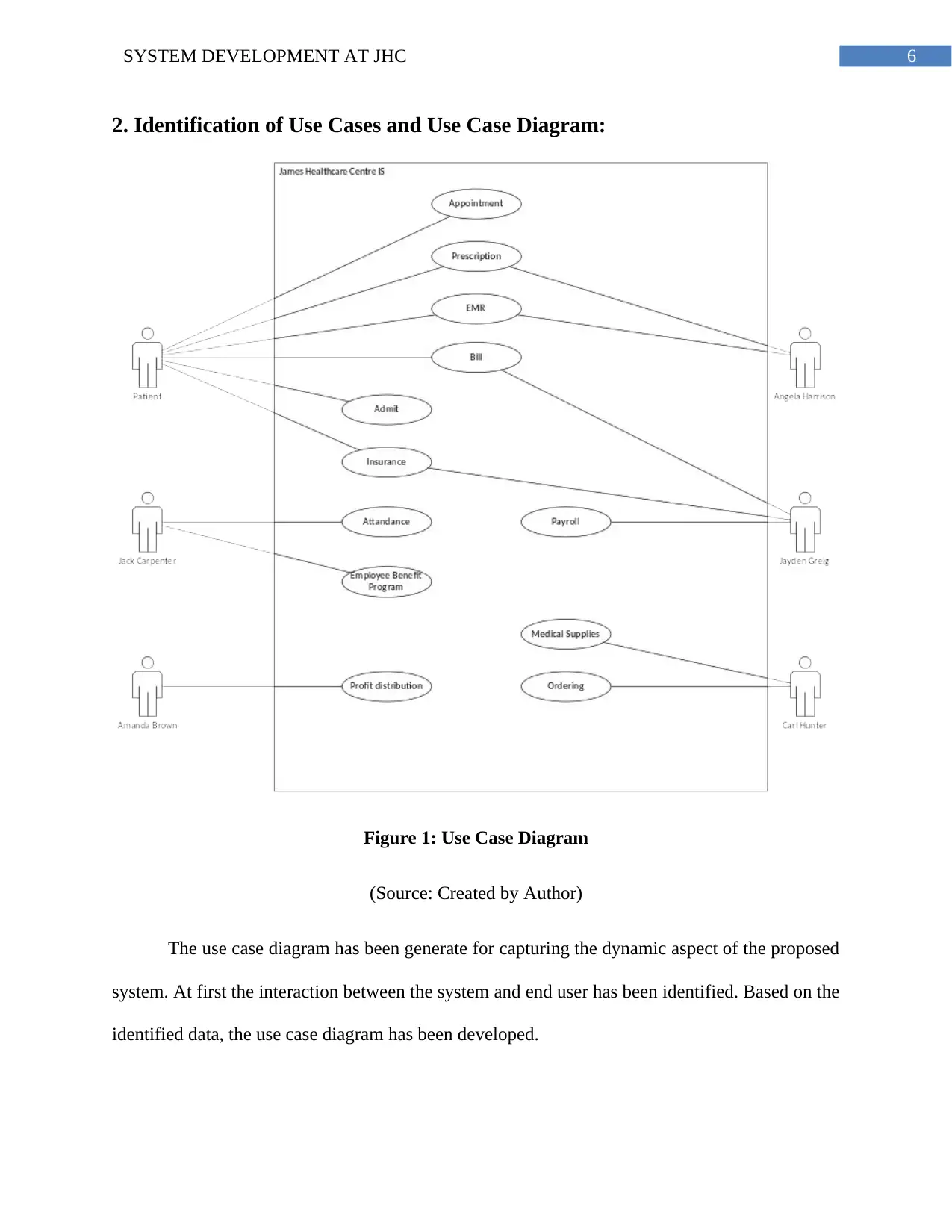
6SYSTEM DEVELOPMENT AT JHC
2. Identification of Use Cases and Use Case Diagram:
Figure 1: Use Case Diagram
(Source: Created by Author)
The use case diagram has been generate for capturing the dynamic aspect of the proposed
system. At first the interaction between the system and end user has been identified. Based on the
identified data, the use case diagram has been developed.
2. Identification of Use Cases and Use Case Diagram:
Figure 1: Use Case Diagram
(Source: Created by Author)
The use case diagram has been generate for capturing the dynamic aspect of the proposed
system. At first the interaction between the system and end user has been identified. Based on the
identified data, the use case diagram has been developed.
Paraphrase This Document
Need a fresh take? Get an instant paraphrase of this document with our AI Paraphraser
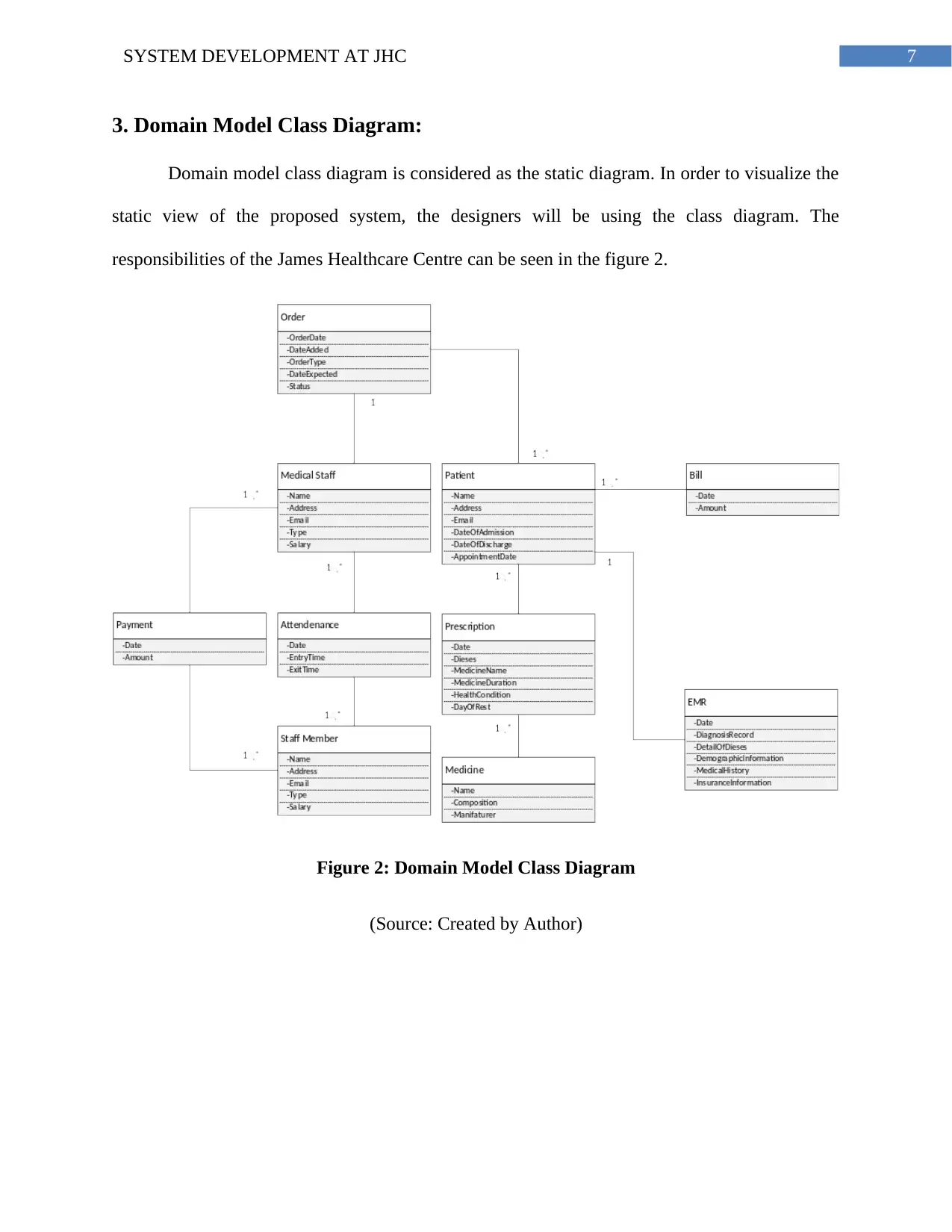
7SYSTEM DEVELOPMENT AT JHC
3. Domain Model Class Diagram:
Domain model class diagram is considered as the static diagram. In order to visualize the
static view of the proposed system, the designers will be using the class diagram. The
responsibilities of the James Healthcare Centre can be seen in the figure 2.
Figure 2: Domain Model Class Diagram
(Source: Created by Author)
3. Domain Model Class Diagram:
Domain model class diagram is considered as the static diagram. In order to visualize the
static view of the proposed system, the designers will be using the class diagram. The
responsibilities of the James Healthcare Centre can be seen in the figure 2.
Figure 2: Domain Model Class Diagram
(Source: Created by Author)
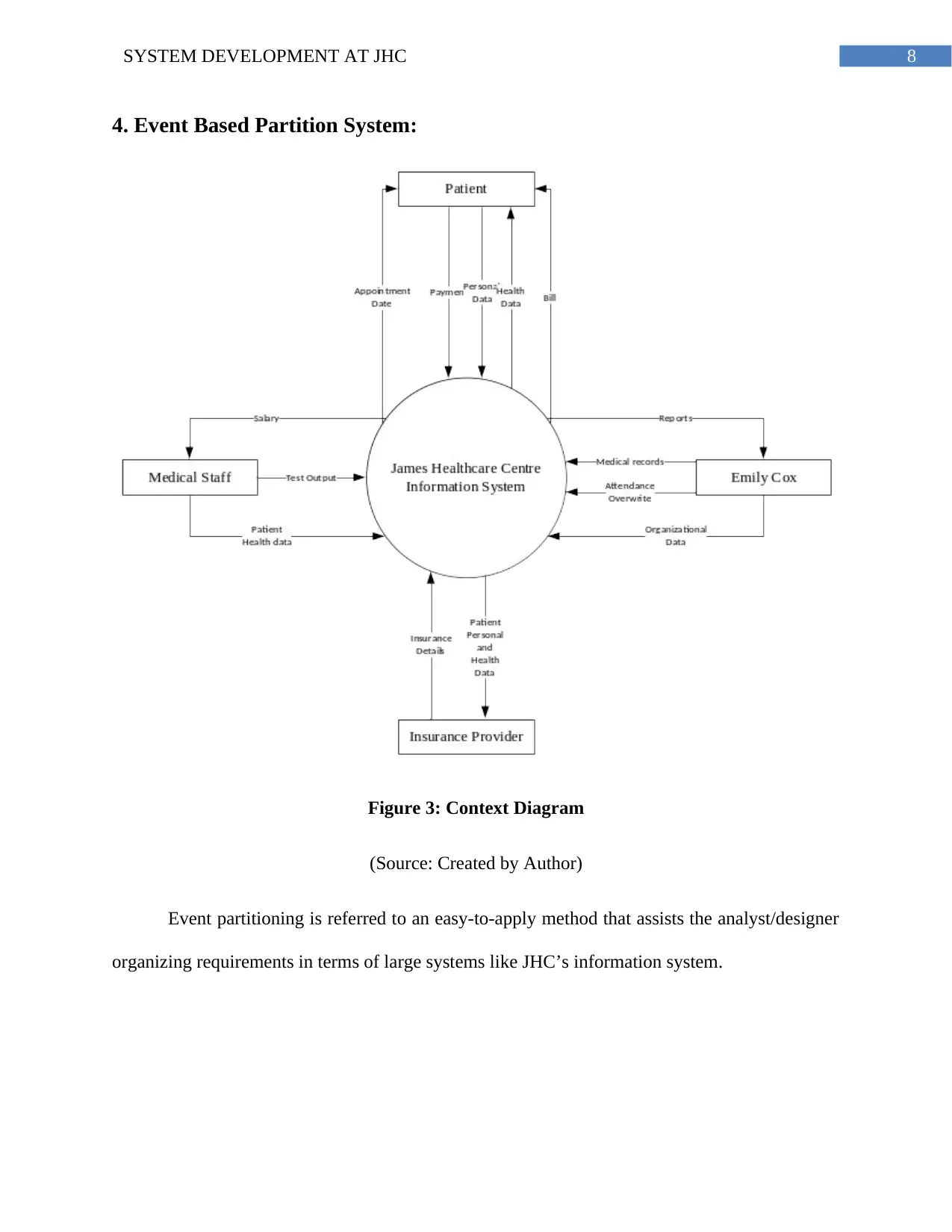
8SYSTEM DEVELOPMENT AT JHC
4. Event Based Partition System:
Figure 3: Context Diagram
(Source: Created by Author)
Event partitioning is referred to an easy-to-apply method that assists the analyst/designer
organizing requirements in terms of large systems like JHC’s information system.
4. Event Based Partition System:
Figure 3: Context Diagram
(Source: Created by Author)
Event partitioning is referred to an easy-to-apply method that assists the analyst/designer
organizing requirements in terms of large systems like JHC’s information system.
⊘ This is a preview!⊘
Do you want full access?
Subscribe today to unlock all pages.

Trusted by 1+ million students worldwide
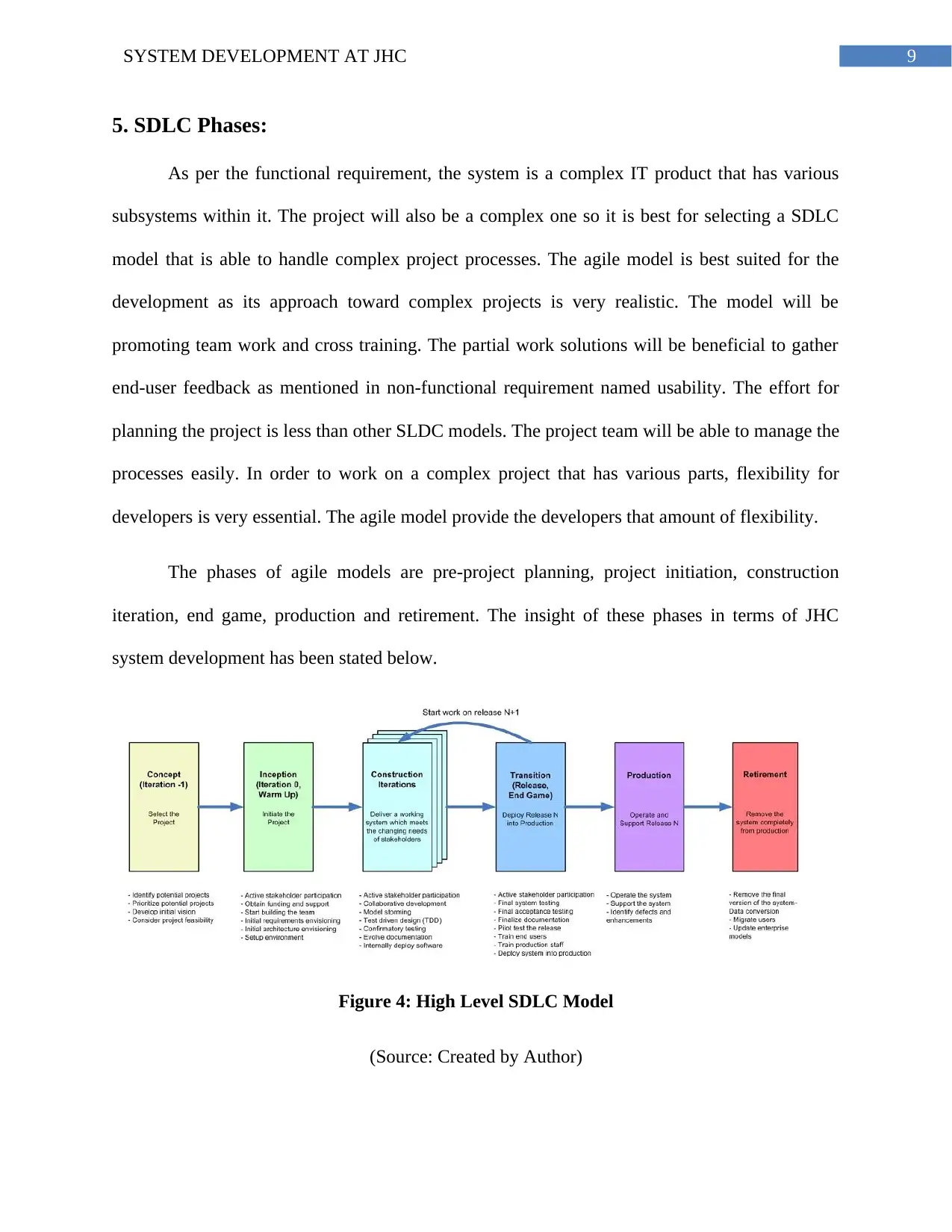
9SYSTEM DEVELOPMENT AT JHC
5. SDLC Phases:
As per the functional requirement, the system is a complex IT product that has various
subsystems within it. The project will also be a complex one so it is best for selecting a SDLC
model that is able to handle complex project processes. The agile model is best suited for the
development as its approach toward complex projects is very realistic. The model will be
promoting team work and cross training. The partial work solutions will be beneficial to gather
end-user feedback as mentioned in non-functional requirement named usability. The effort for
planning the project is less than other SLDC models. The project team will be able to manage the
processes easily. In order to work on a complex project that has various parts, flexibility for
developers is very essential. The agile model provide the developers that amount of flexibility.
The phases of agile models are pre-project planning, project initiation, construction
iteration, end game, production and retirement. The insight of these phases in terms of JHC
system development has been stated below.
Figure 4: High Level SDLC Model
(Source: Created by Author)
5. SDLC Phases:
As per the functional requirement, the system is a complex IT product that has various
subsystems within it. The project will also be a complex one so it is best for selecting a SDLC
model that is able to handle complex project processes. The agile model is best suited for the
development as its approach toward complex projects is very realistic. The model will be
promoting team work and cross training. The partial work solutions will be beneficial to gather
end-user feedback as mentioned in non-functional requirement named usability. The effort for
planning the project is less than other SLDC models. The project team will be able to manage the
processes easily. In order to work on a complex project that has various parts, flexibility for
developers is very essential. The agile model provide the developers that amount of flexibility.
The phases of agile models are pre-project planning, project initiation, construction
iteration, end game, production and retirement. The insight of these phases in terms of JHC
system development has been stated below.
Figure 4: High Level SDLC Model
(Source: Created by Author)
Paraphrase This Document
Need a fresh take? Get an instant paraphrase of this document with our AI Paraphraser
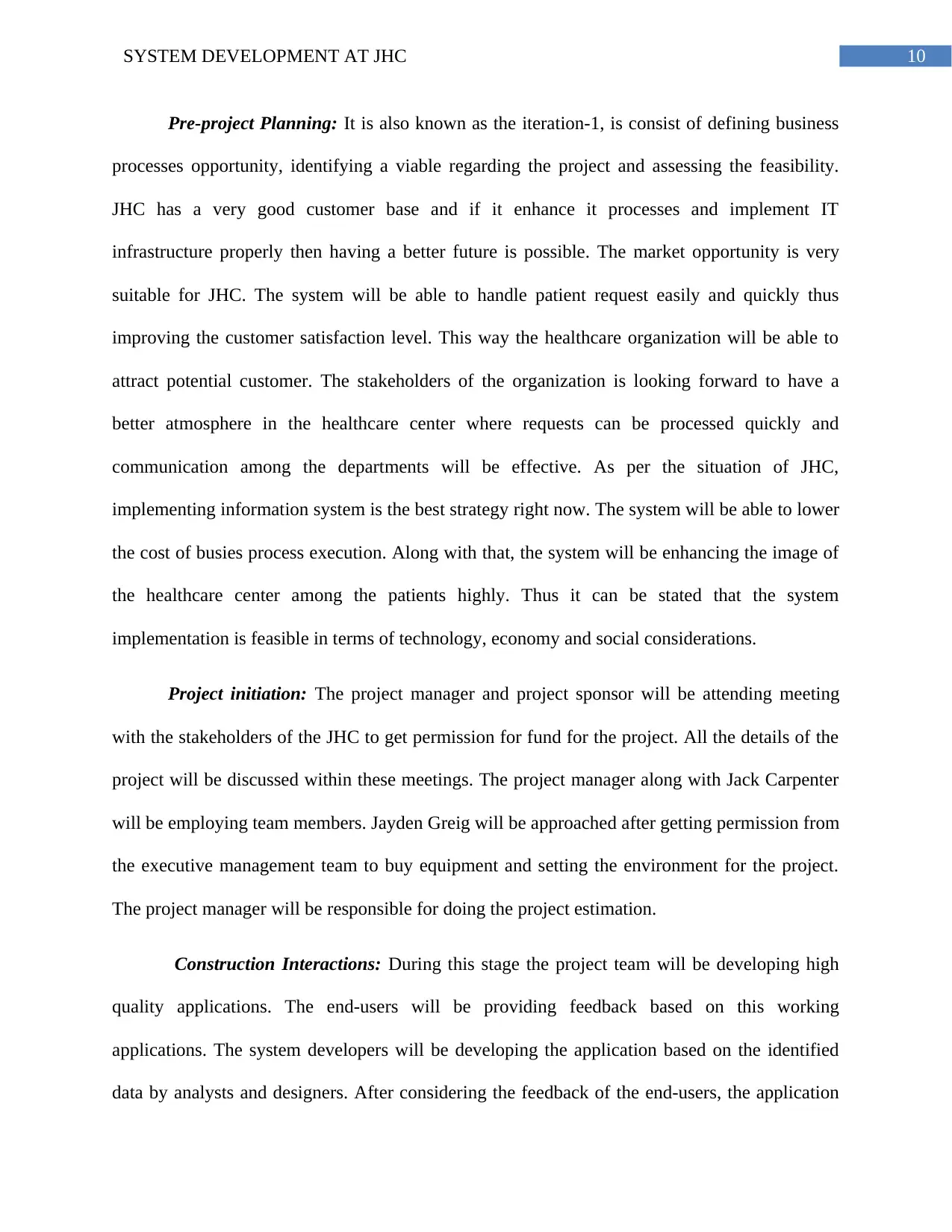
10SYSTEM DEVELOPMENT AT JHC
Pre-project Planning: It is also known as the iteration-1, is consist of defining business
processes opportunity, identifying a viable regarding the project and assessing the feasibility.
JHC has a very good customer base and if it enhance it processes and implement IT
infrastructure properly then having a better future is possible. The market opportunity is very
suitable for JHC. The system will be able to handle patient request easily and quickly thus
improving the customer satisfaction level. This way the healthcare organization will be able to
attract potential customer. The stakeholders of the organization is looking forward to have a
better atmosphere in the healthcare center where requests can be processed quickly and
communication among the departments will be effective. As per the situation of JHC,
implementing information system is the best strategy right now. The system will be able to lower
the cost of busies process execution. Along with that, the system will be enhancing the image of
the healthcare center among the patients highly. Thus it can be stated that the system
implementation is feasible in terms of technology, economy and social considerations.
Project initiation: The project manager and project sponsor will be attending meeting
with the stakeholders of the JHC to get permission for fund for the project. All the details of the
project will be discussed within these meetings. The project manager along with Jack Carpenter
will be employing team members. Jayden Greig will be approached after getting permission from
the executive management team to buy equipment and setting the environment for the project.
The project manager will be responsible for doing the project estimation.
Construction Interactions: During this stage the project team will be developing high
quality applications. The end-users will be providing feedback based on this working
applications. The system developers will be developing the application based on the identified
data by analysts and designers. After considering the feedback of the end-users, the application
Pre-project Planning: It is also known as the iteration-1, is consist of defining business
processes opportunity, identifying a viable regarding the project and assessing the feasibility.
JHC has a very good customer base and if it enhance it processes and implement IT
infrastructure properly then having a better future is possible. The market opportunity is very
suitable for JHC. The system will be able to handle patient request easily and quickly thus
improving the customer satisfaction level. This way the healthcare organization will be able to
attract potential customer. The stakeholders of the organization is looking forward to have a
better atmosphere in the healthcare center where requests can be processed quickly and
communication among the departments will be effective. As per the situation of JHC,
implementing information system is the best strategy right now. The system will be able to lower
the cost of busies process execution. Along with that, the system will be enhancing the image of
the healthcare center among the patients highly. Thus it can be stated that the system
implementation is feasible in terms of technology, economy and social considerations.
Project initiation: The project manager and project sponsor will be attending meeting
with the stakeholders of the JHC to get permission for fund for the project. All the details of the
project will be discussed within these meetings. The project manager along with Jack Carpenter
will be employing team members. Jayden Greig will be approached after getting permission from
the executive management team to buy equipment and setting the environment for the project.
The project manager will be responsible for doing the project estimation.
Construction Interactions: During this stage the project team will be developing high
quality applications. The end-users will be providing feedback based on this working
applications. The system developers will be developing the application based on the identified
data by analysts and designers. After considering the feedback of the end-users, the application
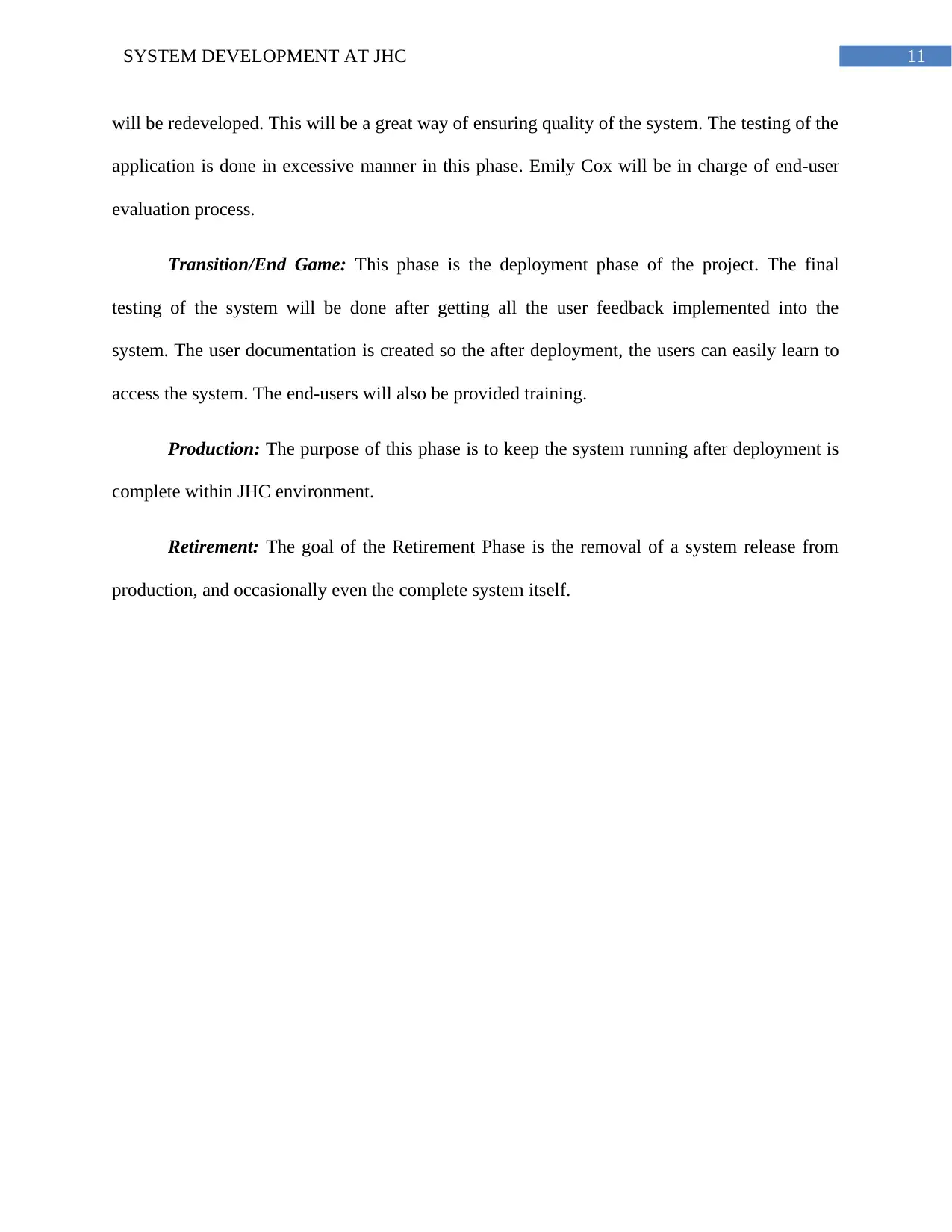
11SYSTEM DEVELOPMENT AT JHC
will be redeveloped. This will be a great way of ensuring quality of the system. The testing of the
application is done in excessive manner in this phase. Emily Cox will be in charge of end-user
evaluation process.
Transition/End Game: This phase is the deployment phase of the project. The final
testing of the system will be done after getting all the user feedback implemented into the
system. The user documentation is created so the after deployment, the users can easily learn to
access the system. The end-users will also be provided training.
Production: The purpose of this phase is to keep the system running after deployment is
complete within JHC environment.
Retirement: The goal of the Retirement Phase is the removal of a system release from
production, and occasionally even the complete system itself.
will be redeveloped. This will be a great way of ensuring quality of the system. The testing of the
application is done in excessive manner in this phase. Emily Cox will be in charge of end-user
evaluation process.
Transition/End Game: This phase is the deployment phase of the project. The final
testing of the system will be done after getting all the user feedback implemented into the
system. The user documentation is created so the after deployment, the users can easily learn to
access the system. The end-users will also be provided training.
Production: The purpose of this phase is to keep the system running after deployment is
complete within JHC environment.
Retirement: The goal of the Retirement Phase is the removal of a system release from
production, and occasionally even the complete system itself.
⊘ This is a preview!⊘
Do you want full access?
Subscribe today to unlock all pages.

Trusted by 1+ million students worldwide
1 out of 15
Related Documents
Your All-in-One AI-Powered Toolkit for Academic Success.
+13062052269
info@desklib.com
Available 24*7 on WhatsApp / Email
![[object Object]](/_next/static/media/star-bottom.7253800d.svg)
Unlock your academic potential
Copyright © 2020–2025 A2Z Services. All Rights Reserved. Developed and managed by ZUCOL.





